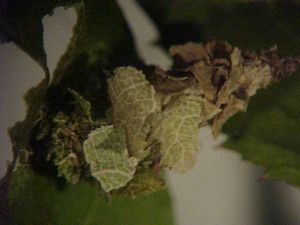When I get one call about an unusual pest I typically tally it as an interesting day. When I get two calls, I begin to wonder. When I get three calls about the same pest issue it’s an infestation. Today I got my third call about bagworms on roses–this one from Janet Laminack in Denton County. My other calls were from Rockwall and Smith counties.
Although bagworms can feed on a variety of different plants, 128 by one count, they generally prefer arborvitae and bald cypress in my part of Texas. The most common species of bagworm (there are 20 species in North America), and one of just a few known bagworm pests, is the evergreen bagworm, Thyridopteryx ephemeraeformis.
Bagworms have one of the more interesting life cycles from a pest management point of view. The female bagworm, it turns out, is wingless. The males emerge from their bags of silk and leaves and cast about for a good-smelling female; but alas, the female is doomed to stay at home in the bag all her days. All this means that bagworms have to be quite ingenious if they are going to disperse to new plants or sites of infestation.
Basically there are just a few ways for bagworms to get around.

Closeup of the silken bag carried by bagworms, festooned with leaves from its host plant. Image courtesy Dr. Keith Hansen.
- crawl, which for a one-inch insect carrying a protective bag around, is not very efficient;
- be blown on the wind when still very small–much more efficient, but one would have to have perfect weather conditions occurring at the same time as the very small bagworm caterpillars were hatching and dispersing; or
- be spread by people–the ultimate road trip for insects.
The bottom line is that bagworms don’t usually move very fast, or very far. So why would we be seeing an uptick in bagworm numbers this year… on plants that they normally are not so common on? The answer is not clear to me, but ideal weather conditions this spring for wind dispersal is my best guess. This, coupled with good conditions for egg hatch and larval survival, could make this a good year for bagworms.
What to do with those bagworms? If you see these insects on your plants, there are several good control options. Bacillus thuringiensis is an old standby, especially for smaller caterpillars. Spinosad is another good low-impact insecticide. After that, or for larger caterpillars, I recommend going to one of the pyrethroid insecticides. I list these last because, even though they are relatively safe for people, they can be a little hard on beneficial insects.

Damage by bagworms to Italian Cypress. Notice the reluctance of the caterpillars to move even a few feet to a different tree. Damage by bagworms to evergreen trees can be severe. Image courtesy Geoff Sherman, North Richland Hills Parks and Recreation.
If you fail to control bagworms now, or they never seem to get bad enough to treat, be sure that you inspect your roses and other plants closely this winter when they have few leaves. Bagworms are one of the few pests that can be effectively removed by hand. Because bagworms generally overwinter in the egg stage (except possibly in south Texas), every bag you remove in the winter holds the potential for hatching 500 to 1,000 eggs the next spring.
If you’ve observed unusual bagworm numbers this year, I’d like to know. Leave a comment in the box below to share your observations.

